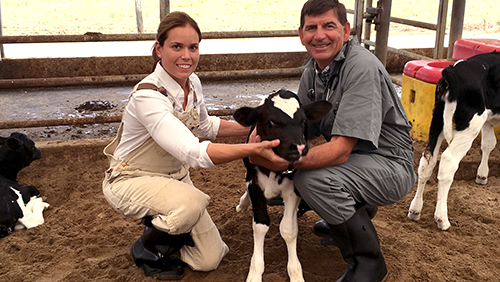 Researchers still have a lot to learn about Crohn’s disease, a chronic form of inflammatory bowel disorder that affects as many as 700,000 Americans. It’s unknown, for example, precisely how heredity, environment, diet, and stress all interact to influence the risk of developing Crohn’s. But new insights into a possible cause of the disease are emerging from a surprising source: cattle researchers at Penn’s School of Veterinary Medicine.
Researchers still have a lot to learn about Crohn’s disease, a chronic form of inflammatory bowel disorder that affects as many as 700,000 Americans. It’s unknown, for example, precisely how heredity, environment, diet, and stress all interact to influence the risk of developing Crohn’s. But new insights into a possible cause of the disease are emerging from a surprising source: cattle researchers at Penn’s School of Veterinary Medicine.
Penn Vet New Bolton Center scientists Marie-Eve Fecteau, an associate professor of food animal medicine and surgery, and Raymond Sweeney, a professor of medicine, are collaborating with Robert Baldassano, a pediatric gastroenterologist at Children’s Hospital of Philadelphia, to investigate the similarities between Crohn’s and Johne’s disease, a chronic wasting disease that affects cattle and other ruminants, and is caused by the bacterium Mycobacterium avium subspecies paratuberculosis, or MAP. Johne’s disease, which is present in nearly 70 percent of dairy cattle herds in the United States, takes a significant economic toll as infected cows produce less milk than their healthy herdmates and must be removed from a herd once their symptoms become severe.
MAP-infected cows share many symptoms with Crohn’s patients: a thickening of the intestines, diarrhea, low protein absorption, and weight loss. In addition, some evidence suggests that MAP may directly play a role in Crohn’s, as the bacterium is found at higher rates in Crohn’s patients than in individuals without the disease.
“It’s a chicken or egg situation,” Sweeney says. “The question is, did MAP enter the intestine and cause the inflammation that causes Crohn’s disease, or did these people have inflamed intestines already and that opens up an avenue that MAP as an opportunist can get in?”
Fecteau and Sweeney are trying to answer this question by focusing on how Johne’s affects a cow’s microbiome, the community of bacteria and other microbes living in the gut, with an eye toward possible therapies that could prevent or temper the effects of an infection.
A study published this past August in PLOS ONE, led by Fecteau and Sweeney, was the first exploration into the association between Johne’s and the microbiome. They looked at cows infected with MAP, MAP-negative cows that had been exposed to MAP-positive herdmates, and MAP-negative cows from a MAP-negative herd. Though the microbiota of all three groups differed, they found a notable reduction in overall bacterial diversity in the infected cows and an increased prevalence of Proteobacteria and Actinobacteria species, a pattern that is also seen in Crohn’s patients.
In a new line of research supported by Penn Vet’s Center for Host-Microbial Interactions, Fecteau, Sweeney, and colleagues are tracking a group of calves from birth to determine how their microbiomes shift based on whether or not they are infected. With a greater understanding of the disease’s course, the researchers hope to find ways to attack it—strategies that could also apply in Crohn’s.
“It would be great to be able to give calves some kind of treatment, perhaps a modulator of the gastrointestinal microbiome, to either prevent infection or even combat an infection before it’s deeply established,” Fecteau says. “That would be a home run.”